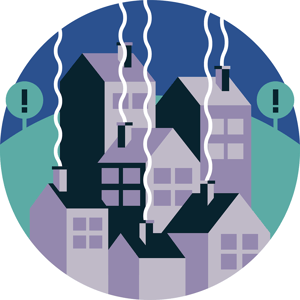How Does Saving Energy Help the Environment?
Like many others, you’re probably trying hard to reduce your impact on the environment. This might involve financial sacrifices or changes to your lifestyle; perhaps you’re avoiding single-use plastic or take your car out less often.
So, remind yourself why you’re going to all that effort.
Wasted energy makes up 30% of the average energy bill - do something about it! Get more from your smart meter with Loop.
A Very Brief History of Climate Change
Since the Industrial Revolution, humans have burned huge quantities of fossil fuels, releasing gases such as carbon dioxide, methane, and nitrous monoxide into the air.
Over time, large quantities of these gases have built up in the atmosphere. This is called the ‘greenhouse effect’; a layer of gases traps the heat from the sun, causing the earth to heat up. The high levels of greenhouse gases in the atmosphere are the leading cause of increasing global temperatures.
To illustrate this, as of 2018, the 20 warmest years on record globally have been in the past 22 years.

The Impacts of Climate Change
If people continue to burn fossil fuels and cut down forests (another activity that contributes to greenhouse emissions, as the carbon stored in trees is released into the air as carbon dioxide) at the same rate, the planet could warm by more than 4°C by 2100. This would have drastic consequences for life on earth.
So far, the impacts of climate change include:
- Rising ocean levels as glaciers and ice sheets melt, and as oceans absorb extra heat from global warming (warmer water expands).
- Ocean acidification as oceans absorb carbon dioxide and become more acidic; this, along with higher temperatures, damages marine ecosystems.
- Extreme weather events, such as heatwaves, droughts, and floods.
- Food insecurity as the effects of global warming - including flooding due to rising sea levels - cause damage to farmland. This, among other problems, can cause people to fight over resources or to migrate.
What Is Being Done
Most countries are committed to helping limit future global warming. A key moment came in 2015, with the signing of the Paris Agreement.
The aim of this agreement is to keep a global temperature rise this century well below 2 degrees Celsius above pre-industrial levels, and to pursue efforts to limit the temperature increase even further, to 1.5 degrees Celsius.
To achieve this will require drastically cutting down on greenhouse gas emissions and switching to renewable energy sources.
In the UK, one of the signatories of the Paris Agreement, the government has committed to a target of ‘net zero’ emissions by 2050.
This doesn’t mean that there will be no emissions of greenhouse gases in 2050, which, remember, is just three decades away. What it does mean is that emissions will be drastically reduced, and any remaining emissions will need to be balanced by removing greenhouse gases from the atmosphere in a process known as 'carbon removal'; this is a major challenge that is expected to be achieved through techniques including planting forests and using chemical to remove gases from the air, as well as by using as-yer undeveloped technologies.

The Role of Saving Energy at Home
Burning fossil fuels to generate electricity and heat buildings is a significant contributor to global warming, accounting for one-quarter of human-made greenhouse gas emissions.
So, saving energy in homes is one of the steps being urged by the Committee on Climate Change (CCC), which advises the government on how to meet its net-zero target.
Significant progress has already been made: the average UK household used around 30% less energy in 2017 than in 1970, mostly due to energy-efficient measures. Small steps can have a big impact; for example, LEDs can use 70 to 90% less energy than incandescent bulbs.
Another important step is to shift away from fossil fuels towards renewable energy, like wind or solar. These renewable sources don’t rely on burning fossil fuels and so emit no or negligible air emissions. Here progress is also being made: half of UK electricity generation in 2017 was from low-carbon sources, including renewable energy.
But progress is less rapid in other areas. For example, heating homes still relies largely on natural gas, which is a fossil fuel. Less than 5% of the energy used for heating homes and buildings comes from low-carbon sources.
Beyond people’s homes, the challenges are perhaps even greater: less than 0.5% of kilometers driven are by low-carbon vehicles (e.g. electric or plug-in hybrid cars) and all flights rely on fossil fuels.
So, the challenge is great. But everyone has the power in their hands to reduce their impact on the environment. Perhaps start with those LED light bulbs?
• • •
Cut Your Energy Bill With Loop
Loop is a FREE energy-saving app that links to your smart meter, analyses your energy use and shows you easy ways to save. On average, Loop users cut their energy use by 15%! How much could you save?



.jpg)




